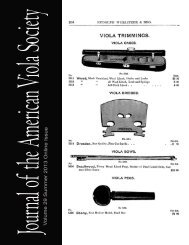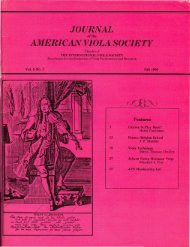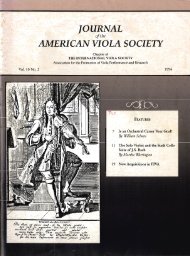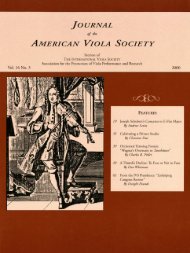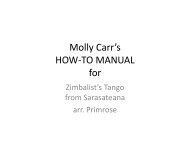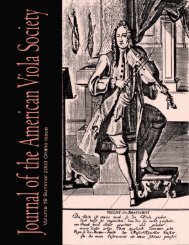Journal of the American Viola Society Volume 26 Online, Summer ...
Journal of the American Viola Society Volume 26 Online, Summer ...
Journal of the American Viola Society Volume 26 Online, Summer ...
Create successful ePaper yourself
Turn your PDF publications into a flip-book with our unique Google optimized e-Paper software.
“Some weeks later Paganini came to see me.<br />
‘I have a marvelous viola,’ he said, ‘an<br />
admirable Stradivarius (dating from 1731),<br />
and I wish to play it in public. Will you<br />
write a solo piece for <strong>the</strong> viola? You are <strong>the</strong><br />
only one I can trust for such a work.’”<br />
Warrack’s Sherlock Holmes and Music puts<br />
<strong>the</strong> question <strong>of</strong> why <strong>the</strong> master detective, in<br />
Watson’s Study in Scarlet, “prattled away<br />
about Cremona fiddles and <strong>the</strong> difference<br />
between a Stradivarius and an Amati,” but<br />
did not mention <strong>the</strong> third great family <strong>of</strong><br />
Cremonese luthiers—<strong>the</strong> Guarneri. Grove’s<br />
dictionary (Vol. IV) supplies <strong>the</strong> answer in<br />
<strong>the</strong> article on Antonio Stradivari:<br />
“His violas bear a more distinctive stamp <strong>of</strong><br />
his creative genius than do his violoncellos.<br />
The changes so apparent in his violins are<br />
quite as evident in <strong>the</strong>se larger instruments.<br />
Before 1690 <strong>the</strong> influence <strong>of</strong> <strong>the</strong> Brescian<br />
school, and <strong>of</strong> <strong>the</strong> Amatis, still ruled <strong>the</strong><br />
properties <strong>of</strong> his violas, but after that year he<br />
adopted a smaller model, and to this he<br />
mainly adhered.”<br />
Sherlock’s Stradvarius, certainly, was a<br />
viola; and it may very well have been an<br />
unusually large viola, since he is shown to<br />
have been experimenting with an alternative<br />
position for playing it.<br />
Warrack believes that Holmes, after his<br />
lucky purchase at <strong>the</strong> pawnshop, must have<br />
hailed a hansom-cab “for a dash to Messrs.<br />
Hill’s in Bond Street, where he learns that<br />
his fiddle is a genuine Stradivarius, worth<br />
nearly two hundred times what he had paid<br />
for it.” There is some documented support<br />
for this belief:<br />
VOLUME <strong>26</strong> SUMMER 2010 ONLINE ISSUE<br />
18<br />
At <strong>the</strong> beginning <strong>of</strong> Chapter III,<br />
“Stradivari’s <strong>Viola</strong>s,” <strong>the</strong> three Hills <strong>of</strong><br />
London, in <strong>the</strong>ir Antonio Stradivari, His Life<br />
& work (1644–1737), a monumental and<br />
exhaustive study published in 1902, <strong>the</strong> year<br />
Holmes retired to beekeeping in Sussex,<br />
commented—“Stradivari made few violas.<br />
We are acquainted with only ten examples.<br />
In an old note-book in our possession <strong>the</strong>re<br />
is a reference to one, dated 1695, but we<br />
have failed to find its present owner.”<br />
Of course <strong>the</strong>y couldn’t find him. Sherlock<br />
Holmes, detective by vocation and violist by<br />
avocation, covered his own tracks as well as<br />
trailed <strong>the</strong> long-cold spoors <strong>of</strong> <strong>the</strong> enemies<br />
<strong>of</strong> society. Even now he may be sitting in an<br />
armchair in <strong>the</strong> dwelling-room <strong>of</strong> his cr<strong>of</strong>t<br />
amid <strong>the</strong> Sussex Downs, leaning back,<br />
closing his eyes, and scraping carelessly at<br />
<strong>the</strong> viola across his knees. Sometimes <strong>the</strong><br />
chords are sonorous and melancholy;<br />
occasionally <strong>the</strong>y are fantastic, for <strong>the</strong><br />
retired master sleuth is experimenting with<br />
<strong>the</strong> type <strong>of</strong> bow used by Corelli and Tartini,<br />
straight for nearly its entire length, curving<br />
downward at <strong>the</strong> point. Holmes has found,<br />
as Roman Totenberg did for <strong>the</strong> violin, that<br />
such a bow makes it possible to play threenote<br />
chords as a unit, ra<strong>the</strong>r than as<br />
arpeggios. The combination is at once<br />
sonorous, melancholy, and fantastic.



